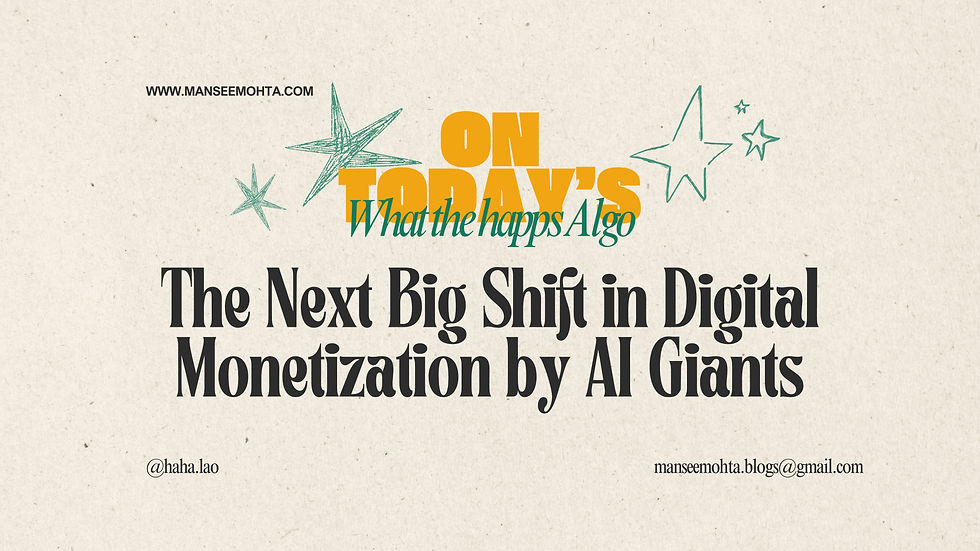AI-Driven Advertising and Monetization
- Mansee Mohta
- Oct 7
- 5 min read

Major tech companies are explicitly designing AI products to drive ad revenue. For example, Meta just announced that all data from its AI chatbot interactions will feed its ad-targeting engine[1]. That means if a user chats about hiking gear with Meta AI, Meta can serve hiking-gear ads on Facebook/Instagram from that data[1][2]. Similarly, Google whose ad business generated $66.9 billion in Q1 2025 alone[3] is integrating ads into its new AI search interfaces. Google’s blog explains that ads will appear “where relevant” in AI-generated Overviews and its new “AI Mode” answers[4]. In one demo, Google’s AI search suggests a website-builder ad when a user asks about building a small business site[4]. These moves turn AI features into additional ad inventory. In short, companies like Meta and Google are building AI models not just as user features, but as channels for targeted advertising (a key revenue driver)[1][3].
AI Chat Data → Targeted Ads: Meta’s policy update highlights that rich AI chat logs provide “powerful signals” for ad targeting[2]. Likewise, Google notes that AI Overviews drive more search queries (including commercial queries), creating extra opportunities for advertisers[5].
Ads in AI Interfaces: Google is testing Search/Shopping ads in its AI Overviews and AI Mode (e.g. “Performance Max” ads can now appear in AI search answers)[4][3]. Other AI platforms (Perplexity, Microsoft Copilot, etc.) are exploring ad inserts too[6].
Ad Revenues Remain Core: Because ads are already Google’s (and Meta’s) primary cash cow, it was “inevitable” they’d extend ads into AI search[3]. Google’s Q1 2025 ad haul alone shows why: its core business depends on showing more ads to more engaged users[3]. By embedding ads into AI chat, companies expect to boost click-through and ROI for advertisers, which in turn grows their own revenues.
Revenue Impact of AI-Based Ads
AI-driven ads create new revenue streams and enhance existing ones. By capturing deeper user intent, platforms can charge more for precision. Meta expects that AI conversation data will refine user profiles and “improve [its] valuable ad products”[2]. Google likewise reports that users who see AI answers tend to search more – a 10%+ increase in query volume in some markets[5] – meaning more chances to serve ads. In practice: Google is expanding ad support (Search/Shopping ads) in AI Overviews and AI Mode, and qualifying existing campaigns (Performance Max, Shopping) to appear in those AI answers[4][3]. This translates directly into more ad clicks and revenue.
Moreover, some AI companies view ads as a way to monetize free products. OpenAI has acknowledged that it may one day adopt an ad-supported model to supplement its subscription income[7]. (Google and Amazon similarly favor their own services in shopping/search, so AI shopping features may mirror that play.) In sum, integrating AI and ads deepens user engagement and ad targeting, thereby strengthening the revenue stream. Companies are effectively turning AI usage into ad impressions or commerce fees, bolstering their bottom line.
Conversational Commerce and Fees
Beyond traditional ads, AI is spawning agentic commerce (in-chat purchasing) as a revenue source. For instance, OpenAI recently launched “Instant Checkout” in ChatGPT: U.S. users can now buy Etsy (and soon Shopify) products directly in-chat[8][9]. Unlike a paid product, ChatGPT’s commerce feature is free for users; instead, merchants pay a small fee per completed sale[10][11]. In practice, ChatGPT surfaces organic product results and when a user taps “Buy,” it handles the payment via Apple/Google Pay or credit card without leaving the chat[12][9]. This model gives OpenAI (and similar AI platforms) a cut of e-commerce transactions – effectively a new revenue slice beyond advertising. As one write-up notes, this in-chat shopping could shift power away from traditional gatekeepers (Google/Amazon) to AI agents, who may take fees or commissions[10][9]. Microsoft’s Copilot and search AI like Perplexity are launching analogous shopping integrations, suggesting a trend: AI agents as commerce brokers with monetization via transaction fees.
![ChatGPT’s new shopping interface (“Buy It in ChatGPT”) lets users purchase items without leaving the conversation[12].](https://static.wixstatic.com/media/091fde_c549f2dbad7746b68769858d9b1ab936~mv2.png/v1/fill/w_959,h_753,al_c,q_90,enc_avif,quality_auto/091fde_c549f2dbad7746b68769858d9b1ab936~mv2.png)
Platform Examples: Zomato, Swiggy, etc.
Many modern “platform” businesses rely heavily on selling ads or visibility rather than just their core service. A prime example is Indian food platforms like Zomato and Swiggy. Zomato’s own analysis shows that food delivery (with thin margins) is only a small fraction of its revenue[13]. Instead, “Zomato’s primary source of revenue is advertising.” Restaurants pay for top-of-list or banner placements to reach customers[14]. In other words, Zomato has built a high-frequency marketplace and monetizes not just delivery fees, but the data and exposure it offers partner restaurants. Similarly, Swiggy earns from restaurant commissions, delivery fees, and an expanding in-app advertising business. Restaurants on Swiggy can buy priority listings to boost visibility, and Swiggy explicitly cites in-app ads as a revenue source[15][16]. Both cases illustrate that ad-driven revenue can outpace the core product revenue. In fact, Zomato’s and Swiggy’s growth strategies emphasize that connecting advertisers (restaurants, brands) to the platform’s users is more lucrative than the delivery service itself[14][16].
Key Takeaways: Leading tech firms are indeed creating AI models with monetization in mind. AI chat and search are being directly leveraged to insert ads and generate commerce fees, which enriches companies’ revenue streams[1][10]. Many modern businesses (from Google to food-delivery apps) follow a pattern: offer a free or low-margin service and earn primarily through advertising or platform fees. The Zomato/Swiggy example shows that even outside of big tech, companies design business models where data and ads can become the biggest moneymakers[14][16].
Sources: Recent TechCrunch and official reports highlight these trends (Meta’s AI ad plan[1]; Google’s AI search ads[4][3]; OpenAI’s shopping integration[10][11]) as well as analyses of Zomato/Swiggy business models[14][16]. All cited facts are drawn from these industry sources.



![Zomato and Swiggy illustrate multi-sided platforms. Both charge restaurants for advertising/promoted listings (in addition to delivery commissions)[14][16].](https://static.wixstatic.com/media/091fde_3c1480e1b42f42b88f648e1fd9498fde~mv2.jpg/v1/fill/w_980,h_551,al_c,q_85,usm_0.66_1.00_0.01,enc_avif,quality_auto/091fde_3c1480e1b42f42b88f648e1fd9498fde~mv2.jpg)



Comments